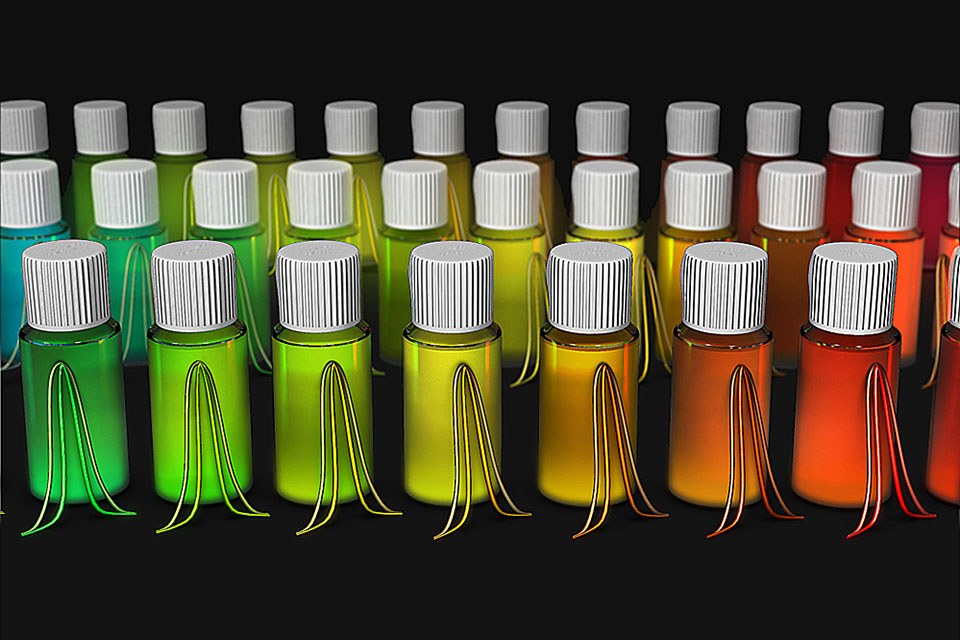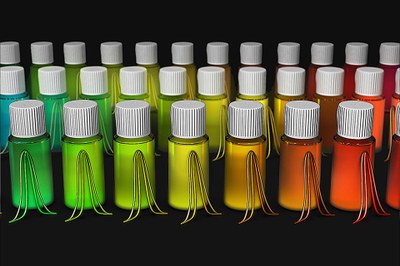MIT Demonstrates New Method for Fine-Tuning Emissions from Quantum Dots
Tiny particles of matter called quantum dots, which emit light with exceptionally pure and bright colors, have found a prominent role as biological markers. In addition, they are realizing their potential in computer and television screens, and have promise in solid-state lighting. New research at MIT could now make these quantum dots even more efficient at delivering precisely tuned colors of light.
Advantage of the new fine-tuning process:
Vials containing colloidal semiconductor quantum dot nanocrystals (NCs) emit colors that are determined by the exact size of the particles. In the image, curves in front of each vial show the measurements made by the MIT team: The outer, wider curve shows the spectrum of colors from all the NCs in that vial, while the narrower curve shows the average single-particle spectrum within that vial. Until this new technique was developed, there was no way to tell whether the width of the spectrum in a given batch was caused by different NCs in the batch having slightly different colors, or whether each particle's emissions had a wider spectrum.
These materials, called colloidal semiconductor quantum dot nanocrystals, can emit any color of light, depending on their exact size or composition. But there is some variability in the spread of colors that different batches of nanocrystals produce, and until now there has been no way to tell whether that variability came from within individual particles or from variations among the nanocrystals in a batch.
That’s the puzzle an MIT team has now solved, using a new observational method. The results appear in the journal Nature Chemistry in a paper by chemistry professor Moungi Bawendi, graduate student Jian Cui, and six others.
For many applications — such as flat-panel displays — it’s important to make particles that emit a specific, pure color of light. So, it’s important to know whether a given process produces nanocrystals with an intrinsically narrow or broad spectrum of color emission.
“You need to understand how the spectrum of a single particle relates to the spectrum of the whole ensemble,” Cui says. But existing observational methods that detect an entire ensemble produce data that “is blurring the information,” and methods that attempt to extract data from single particles have limitations.
Observing billions at once:
The new method, developed in Bawendi’s lab, is a radical departure from conventional means of observing light emissions from single emitters. Normally, this is done by isolating individual emitters, stabilizing them on a substrate, and observing them one at a time.
But this approach has two drawbacks, Bawendi explains: “You only get small numbers, because you’re looking at one at a time, and there’s a selection bias, because you usually look at the bright ones.”
The new method — called photon-correlation Fourier spectroscopy in solution — makes it possible to extract single-particle spectral properties from a large group of particles. While it doesn’t tell you the spectral peak width of a specific particle, it does give you the average single-particle spectral width from billions of particles, revealing whether the individual particles produce pure colors or not.
In addition, Bawendi explains, the particles “are not isolated on a surface, but [are] in their natural environment, in a solution.” With the traditional methods, “There’s always a question: How much does the surface affect the results?”
The method works by comparing pairs of photons emitted by individual particles. That doesn’t tell you the absolute color of any particular particle, but it does give a representative statistical measure of the whole collection of particles. It does this by illuminating the sample solution with a laser beam and detecting the emitted light at extremely short time scales. So while different particles are not differentiated in space, they can be differentiated in time, as they drift in and out of the narrow laser beam and are turned on by the beam.
“We get the average single-particle line width in the solution, without any selection bias,” Cui says. By applying this method to the production of quantum dot nanocrystals, the MIT team can determine how well different methods of synthesizing the particles work.
Fine-tuning the process:
“It was an open question whether the single-dot line widths were variable or not,” Cui says. Now, he and his colleagues can determine this for each variation in the fabrication process, and start to fine-tune the process to produce the most useful output for different applications.
In addition to computer displays, such particles have applications in biomedical research, where they are used as staining agents for different biochemicals. The more precise the colors of the particles are, the greater the number of different colored particles that can be used at once in a sample, each targeted to a different kind of biomolecule.
Using this method, the researchers were able to show that a widely used material for quantum dots, cadmium selenide, does indeed produce very pure colors. But, they found that other materials that could replace cadmium selenide or produce different colors, such as indium phosphide, can also have intrinsically very pure colors. Previously, this was an open question.
Todd Krauss, a professor of chemistry at the University of Rochester who was not involved in this research, says the MIT team’s “approach is very clever and builds on what this group has done previously.” Measuring the line widths of individual particles is important, he says, in optimizing applications such as television displays and biological markers. He adds, “We should be able to make much better strides now that this technique is published, because of the ability to get single-particle line widths on many particles at once.”
The work was supported by the U.S. Department of Energy and by the National Institutes of Health.


